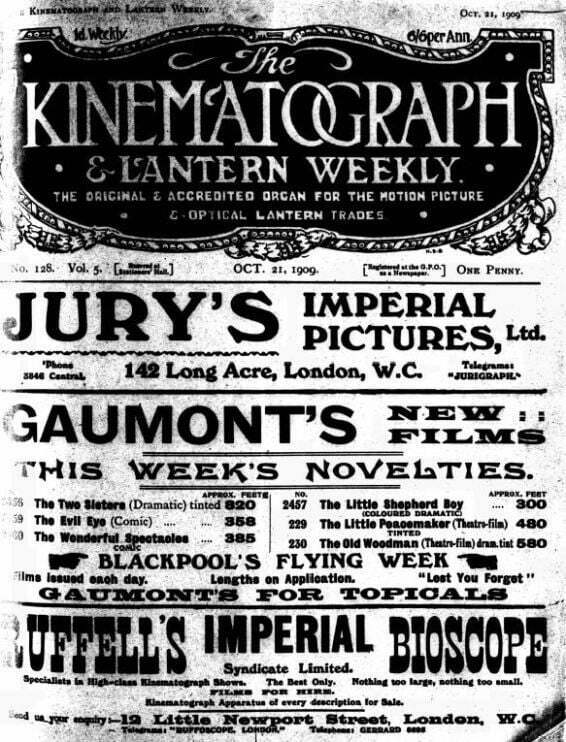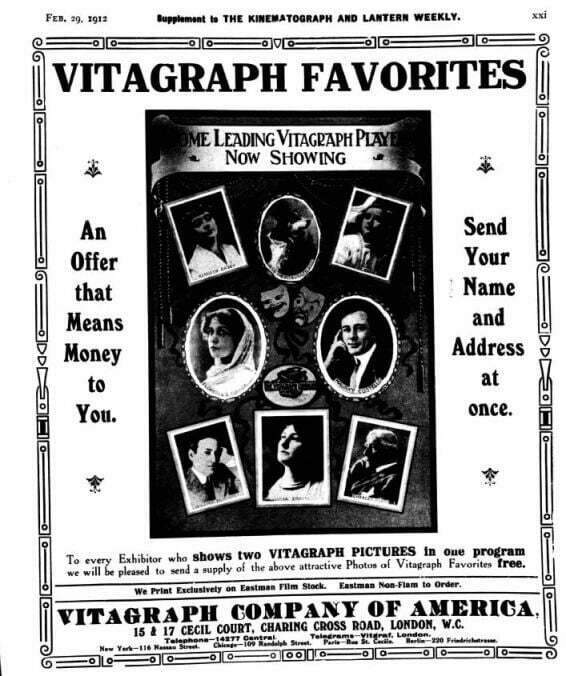
After the happy news back in 2018 that The Bioscope, the leading silent era British film journal, had been digitised for the British Newspaper Archive, some would come up to me and ask, what about the other leading silent era British film journal? What about the Kinematograph Weekly? Ah, I would say. That would be nice, but the fact is I don’t know. No, honestly, I don’t know. Others would send emails, saying could I please tell them if it might happen, and not to worry, they promised not to tell a soul. Again, I said I knew nothing. But I lied.
The truth will out. So I am delighted to be able to report that Findmypast, the company that digitises the British Library’s newspapers (and some journals) and publishes the British Newspaper Archive, has started work on the Kinematograph Weekly. It’s just a start so far, with the years 1904-1914 published online, but more is promised in time. The journal ran from 1904 to 1971 (there was a predecessor title, The Optical Magic Lantern Journal, which began in 1889), going through four titles in the process:
1904–07 Optical Lantern and Cinematograph Journal
1907–19 Kinematograph and Lantern Weekly
1919–59 The Kinematograph weekly
1959–71 Kine Weekly [Findmypast plans only to digitise to 1960]

It was published weekly, and, as its 1904-07 title suggest, was originally aimed as much as the magic lantern trade as the burgeoning film business. Its original publisher was E.T. Heron, its editor was Theodore Brown, an inspired inventor of optical technologies in his own right (he was a pioneer of 3D cinema, for example). Another notable editor in these early years was Low Warren, in charge 1912-17, whose 1937 book The Film Game is a much-treasured account of the early years of cinema in Britain. As with the Bioscope, it was aimed at the trade rather than the fans. Consequently it is full of the kind of practical information that is so important to the early film historians: advertisements, reviews and summaries of films, technology reports, business commentaries, reviews of regional, national and international film business, studies of legislation, advice to industry practitioners, and accounts of film exhibitions. It reflects the beating heart of an industry growing from strength to strength.
That’s just for the early years, of course. The Kinematograph and Lantern Weekly, as it was known from 1907 to 1919, became The Kinematograph Weekly, as it followed the industry into the era of mass popularity, when everyone went to the cinema. It followed the transition from silent to sound cinema, the rise of colour, the many technological developments, the changes in film style and taste, and then – inevitably – the appearance of television, the technology that would swiftly supplant cinema in the hearts of the public. Named Kine Weekly for its final years of publication, it bowed out in 1971 as the industry it had seen grow almost from its very start, contracted. The film trade stopped reading it, but ever since then the historians have taken over.

There was an attempt by the University of East Anglia, if not to digitise, then at least to index, selected years from the Kinematograph Weekly, back in the early 2000s. The British Cinema History Research Project did not entirely succeed even in its limited aims, but its index remains online at www.kineweekly.uea.ac.uk. Thereafter British film journals lagged behind as others from the USA, Italy and France in particular were digitised in bulk and published online. The founding by David Pierce of the Media History Digital Library in 2010, bringing together large collections of mostly American film (and other media) journals on one discovery platform, with the journals themselves hosted by the Internet Archive, has utterly transformed early film studies.
There are some British titles on the MHDL, though not always complete runs: The Bioscope (1930-1932), The Cine Technician (1935-1956), a selection of The Cinema News and Property Gazette (1912-1946), Documentary News Letter (1940-1949), some of Pictures and the Picturegoer (1915-1937), and a few months of the Kinematograph and Lantern Weekly‘s predecessor, The Optical Lantern and Cinematograph Journal (1904-1905). Importantly, it has volumes of the annual Kine Year Book (1927-1954, with some gaps), the companion work to the Kinematograph Weekly. The early film historian is now richly served.

Of course, the Media History Digital Library is open to all, while the British Newspaper Archive is a subscription site. That’s how it goes. Something has to pay for the digitisation, and the BNA’s commercial model has been a highly successful one, making nearly 40 million pages of newspapers from the 17th to the 21st century available online for a modest monthly fee. It has made a huge newspaper archive available to anyone anywhere, benefitting countless researchers, as well as the family history users who form the bedrock of Findmypast’s business.
It’s a lot of pages, but still only around 8% of the British Library’s newspaper collection, and it has taken us ten years to get to such a figure. There is a long way to go, but so many treasures to make available along the way.
So, do I know what else might be in the pipeline for the film historian? No I don’t. No, honestly, I do not. I promise. Why won’t you believe me?
Links:
- The Kinetograph Weekly is available on the British Newspaper Archive. It has been digitised from the microfilm set held by the British Library
- The years 1907-1941 of The Kinematograph Weekly are also available on the Entertainment Industry Magazine Archive, an electronic subscription service from ProQuest, aimed at institutions not individuals
- There is a superlative biography of Theodore Brown, Stephen Herbert’s Theodore Brown’s Magic Pictures: The Art and Inventions of a Multi-Media Pioneer – not easy to track down, but well worth any effort
That’s wonderful news. But didn’t Lawrence Napper, then at University of East Anglia get a research grant to start this process . . . although I think they didn’t get money for a second tranche and I don’t know how public the results are. But it would save a lot of time and effort if the two initiatives could be linked.
Secondly is there any prospect of digitisation for the very useful Motion Picture Studio which ran as an adjunct to Kine Weekly 1921-1924 focused on the creatives. I’ve always thought it should be anthologised it’s such a vital insight into how people working on film production were thinking.
I’ve not across any recent plans from academia to digitise the KW. UEA did have a project back in 2001, led by Charles Barr, with Lawrence Napper on the team, which produced an index to some issues, but no more than that. I think they rather overreached themselves completing what they did. The field of newspaper digitisation has been taken over since then by international academic platforms (e.g. Cengage Gale) and family history companies (e.g. Findmypast) who can manage such work at scale.
I can’t speak for Findmypast’s future plans for the British Newspaper Archive and film journals, and have no influence over this. If I get the chance, I’ll mention Motion Picture Studio to them at least.
The Motion Picture Studio is available on the Internet Archive (and via the Media History Digital Library) for Jun 1921-Feb 1924, after which date it was absorbed by the Kinematograph Weekly. Currently the months Feb-June 1923 are missing from the set: https://mediahist.org/features/publications-volumes.php?id=The%20Motion%20Picture%20Studio
Hi,I have a collection of over 900 kine weekly 1942- 1962 very good condition no cut outs centre folds intact, please could you point me in the right direction to sell them, I’m in the n.east England, many thanks, regards Robert
Hi there Robert
I was wondering if you still have the kine weekly magazines for sale?
Regards Dave
Sorry, I can’t advise. I have noticed that there are quite a number of individual Kine Weekly issues appearing on eBay just now.
How can I get good quality copies of two photos from Kinematograph Weekly in 1928
Normally I would recommend going to the British Library, which holds a complete run and has a imaging service, but because of the ongoing fallout from last year’s cyberattack, there is no access available to the newspapers and journal they store in Yorkshire. So you need to go to an institution that has a physical set. The British Film Institute has one (contact the BFI Reuben Library – https://www.bfi.org.uk/bfi-reuben-library). I believe that there are sets (not necessarily complete) at the National Library of Scotland, the National Library of Wales and the University of East Anglia. The Cinema Museum in London also has a set. Note that any institution holding copies of the Kine Weekly will not hold any rights in it and may not want to make copies of any photographs without evidence of copyright clearance being provided.